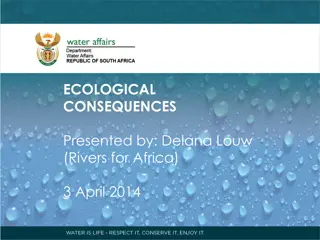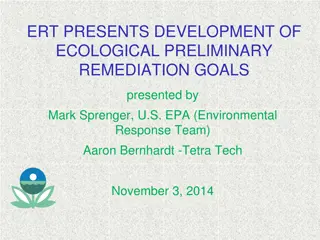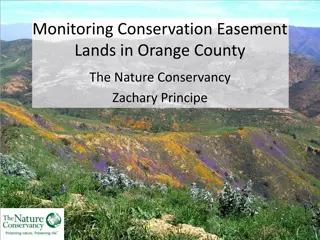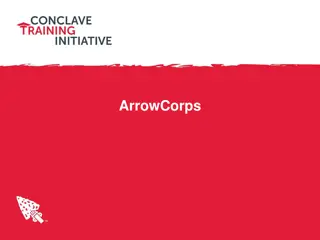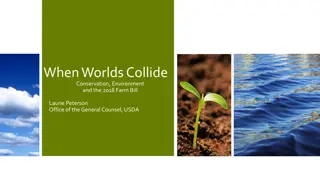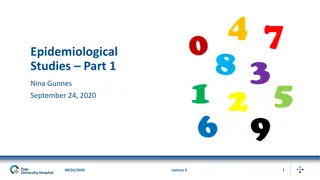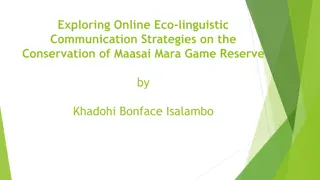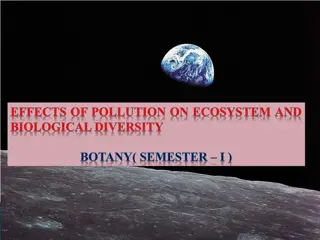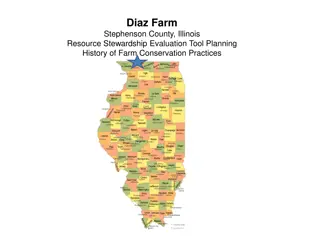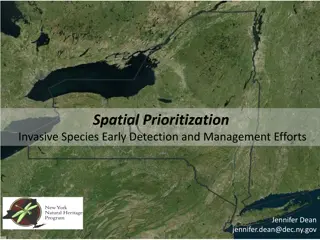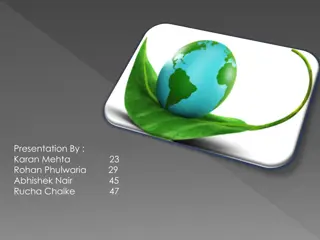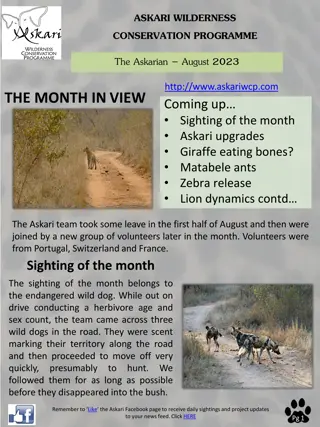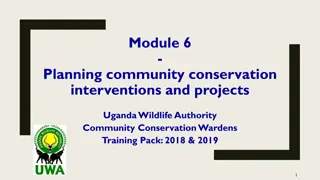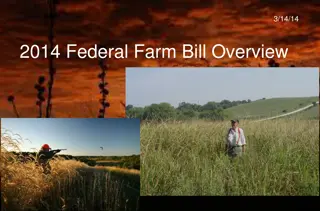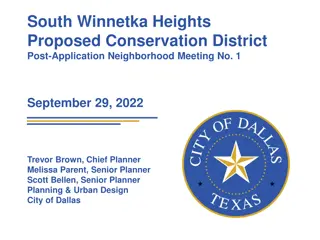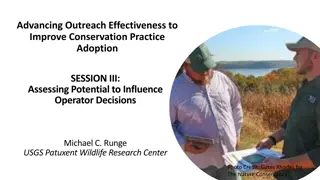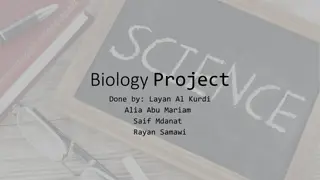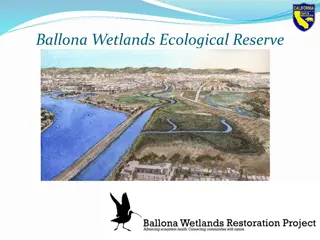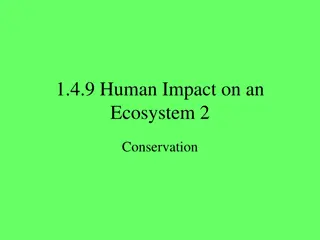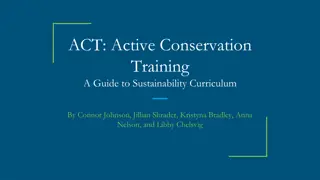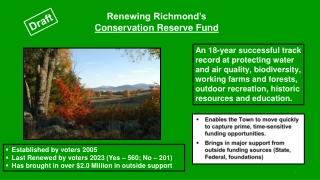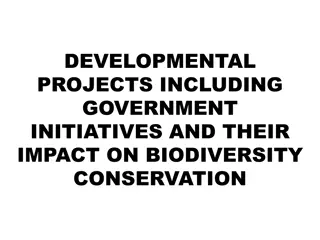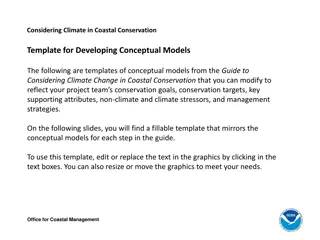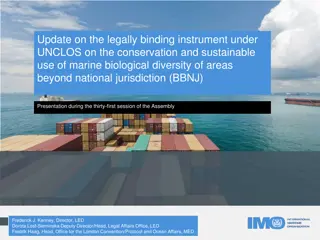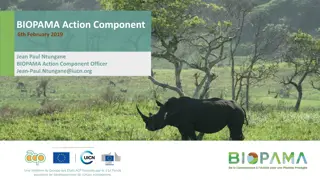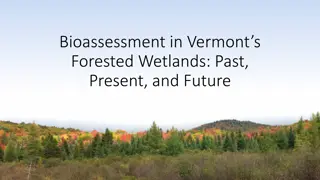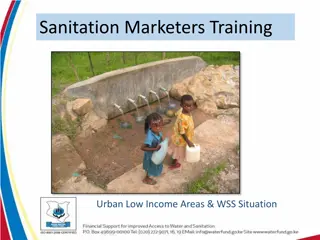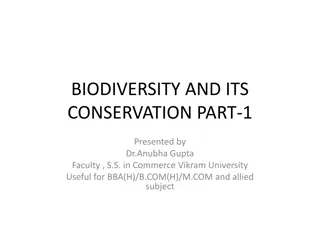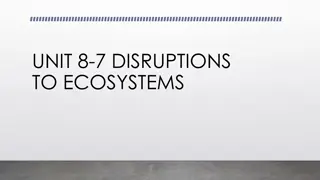Ecological Consequences Assessment for Conservation Areas
Determining the ecological consequences of various scenarios is crucial for conservation efforts. The assessment focuses on changes in geomorphology, physico-chemical properties, fish populations, macroinvertebrates, and riparian vegetation. By evaluating scenarios based on ecological significance, confidence levels, and river lengths, the study ranks the options for sustainable management of ecosystems in MVOTI, MKOMAZI, and UMZIMKULU. The results highlight the impacts of human interventions like dam construction on habitat quality and the importance of considering ecological objectives for maintaining biodiversity.
- Ecological Consequences
- Conservation Areas
- Scenario Evaluation
- Ecosystem Management
- Biodiversity Conservation
Download Presentation

Please find below an Image/Link to download the presentation.
The content on the website is provided AS IS for your information and personal use only. It may not be sold, licensed, or shared on other websites without obtaining consent from the author. Download presentation by click this link. If you encounter any issues during the download, it is possible that the publisher has removed the file from their server.
E N D
Presentation Transcript
MVOTI TO UMZIMKULU NWRCS DWA CORPORATE IDENTITY Presented by: Johan Maree Deputy Director: Media Production MVOTI & MKOMAZI RIVER ECOLOGICAL CONSEQUENCES: 12 December 2012 Delana Louw Rivers for Africa 26 November 201
Determining ecological consequences of scenarios Need to answer the what if questions Express in terms of change in Ecological Category AND degree in which the REC is met Detailed process to predict changes in all the biophysical components per site and per scenario. Then to integrate and demonstrate in systems context Include in MC DSS process 2
Determining ecological consequences of scenarios Geomorphology Geomorphology Geomorphology AVERAGE SCORE FOR EACH SCENARIO & STANDARDISE TO 1 Physico-chemical Physico-chemical Physico-chemical Fish Fish Fish Macroinvertebrates Macroinvertebrates Macroinvertebrates Riparian vegetation Riparian vegetation Riparian vegetation Consequences EC FOR PES & REC Consequences EC FOR SC Consequences COMPARE EC TO REC Evaluate scenarios Determine PES, REC and % Predict EC and % Determine degree to which REC is met Rank Scenarios at each EWR site
Determining ecological consequences of scenarios Ecological ranking of scenarios per EWR site RELATIVE ECOLOGICAL IMPORTANCE OF SITES PES EIS Locality in conservation areas Confidence Length of river APPLY WEIGHT TO OUTPUT Ecological ranking of scenarios for the system WEIGHT
MKOMAZI RESULTS: MK_1_EWR Geomorp: Impact of the dam on sedimentation and possible erosion and accumulation of fines. Results in habitat changes. Lack of fast flowing habitats and possible reduction and/or eradication of ANAT and BNAT (Sc 2&4 no EWR) Scenarios that include EWR releases are an improvement, but the unseasonal releases and at times higher flows than natural are problematic. Most scenarios meet the ecological objectives in terms of EcoStatus except for Sc MK4 and MK2 (no EWR) None of the scenarios meet the ecological objectives for all the components. Sc Mk 21 are the best of the options overall and is therefore ranked the highest D Proposed Smithfield Dam MK_I_EWR 1 MK_I_EWR 1 C MK_I_EWR 2 MK_I_EWR 3 C/D Sappi Estuary
MKOMAZI RESULTS: MK_2_EWR Geomorp: Impact of the dam on sedimentation and possible erosion and accumulation of fines. Results in habitat changes. The other scenarios include increased high flows in the dry season with a loss of slow habitats which impact on fish. None of the scenarios meet the ecological objectives. Although Sc MK21, 41 and 42 results in the same EcoStatus, the instream biota are impacted by the reduced wet season base flows and reduced floods. Sc MK41 is the best scenario of these three scenarios because it provides more flows during wet season. Scenario MK2 and MK4 have the worst impact due to reductions in baseflows during dry and wet seasons. B Proposed Smithfield Dam MK_I_EWR 1 B/C MK_I_EWR 2 MK_I_EWR 2 C MK_I_EWR 3 Sappi Estuary
MKOMAZI RESULTS: MK_3_EWR Geomorp: Less severe impacts than us. Deterioration in instream biota (small), is related to the low flows for drought in wet months and impact on spawning Sc MK 21, 31 and 41 result in the same EcoStatus and have the least impact with a slight deterioration in geomorphology and instream biota. Sc MK22, 23, 32 and 33 also have the same EcoStatus as the PES/REC but there is further deterioration in the instream biota as well as geomorphology and water quality. Scenario MK2 and 4 have the biggest impact as overall they drop a category for while Sc MK42 only caters for the low flow EWR and the impact is therefore slightly less, i.e. it drops half a category D 1.00 PES REC Proposed Smithfield Dam 0.96 Sc MK21, 31 & 41 MK_I_EWR 1 C 0.92 Sc MK22, 23, 32 & 33 Sc MK42 MK_I_EWR 2 C/D 0.88 0.84 MK_I_EWR 3 MK_I_EWR 3 Sc MK2 & 4 Sappi 0.80 Estuary
MKOMAZI RIVER: INTEGRATED CONSEQUENCES PES REC Sc MK2 Sc MK21 Sc MK22 & 23 Sc MK31 Sc MK32 & 33 Sc MK4 Sc MK41 Sc MK42 PES REC 0.98 Sc MK21 Sc MK41 0.93 Sc MK31 Sc MK22 & 23 Sc MK42 0.88 Sc MK32 & 33 0.83 Sc MK4 0.78 0.73 Sc MK2 0.68 Mk_I_EWR1 Mk_I_EWR2 Mk_I_EWR3 Where the line crosses, the ranking order between sites are different. To determine a system ranking, need to weigh the sites
MKOMAZI RIVER: SITE WEIGHTING Locality in protected areas Proposed Smithfield Dam EWR site Normalised Weight PES EIS Conf Dist MK_I_EWR 1 EWR 1 EWR 2 EWR 3 Moderate 3.4 1 0.08 C 0.22 MK_I_EWR 2 High 3.5 3 0.32 B 0.37 Moderate 3.4 1 0.6 C 0.41 MK_I_EWR 3 MK_I_EWR 3 Sappi Estuary
MKOMAZI RIVER: INTEGRATED RANKING Sc MK 21 and 41 are the best options as they are the closest to meeting the ecological objectives. Both these scenarios include the total EWR flows and the impacts are mostly due to the impacts on the dam itself, such as the barrier effect, impact on larger frequency of floods and largely due to the increased (above natural) base flows.
MVOTII RESULTS: MV_I_EWR2 Sc MV3 is the worst case as it does not include EWR releases. The channel will narrow with vegetation encroachment. An overall loss of fast habitats will impact on the instream biota. Impacts associated with Sc MV42 and 43 are less pronounced as it includes EWR releases to some degree. Sc MV 41 supplied the total EWR and therefore meets the ecological objectives. C D


